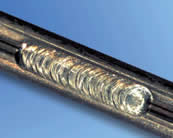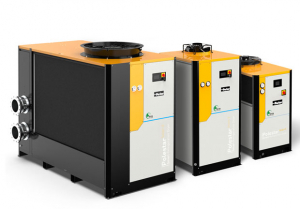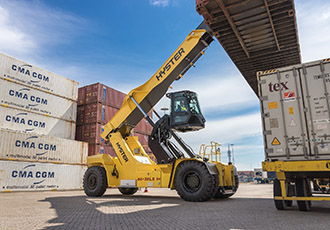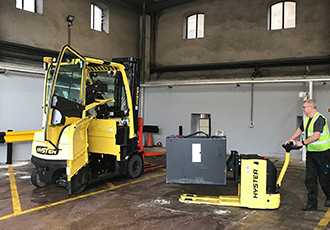Rofin-Baasel meets the challenges of precision laser processing within the medical device sector
23rd April 2009
Source:
Rofin-Baasel UK Limited

Industrial laser applications within the medical device industry form a significant part of Rofin-Baasel’s business globally. Most of the laser applications within the medical device industry are ‘micro’ in nature; on components down to sub-mm in size. These applications include the common laser processes of cutting, welding, marking, drilling and surface treatments but across a wide range of materials and devices, both metallic and plastic, and from implants to instrumentation.
For many years laser micro cutting and laser marking have been core medical product processes. Laser welding however, continues to be a fast growing application area within the medical device sector, and as such poses a new set of challenges for suppliers as they strive to adhere to the rigorous process and quality standards demanded by the industry. A combination of unrivalled application experience and innovative product development has enabled Rofin-Baasel to provide robust welding solutions to the medical device industry
New challenges for laser welding
The quality of laser cutting and marking is in the main easy to assess. Visual inspection using relatively low magnification will in general easily reveal process defects. By contrast, for the inspection of laser welding, there is no comparable optical method for determining weld volume or defects, except to identify obvious gross defects. Most of the metallic implantable medical devices used within the industry are welded with lamp-pumped Nd:YAG lasers, using a combination of single-shot spot welding and seam welding. The pulsed laser operation enables rapid local heating and cooling, avoiding collateral thermal damage. The devices produced using this process are often wires, tubes, or assemblies combining both, with outside diameters as little as 200-300 μm, and made from Stainless Steels, Nitinol or combinations of materials.
Destructive testing can of course only be performed on a few assemblies, therefore laser welded medical device conformity requires, amongst other things, extremely tight monitoring and control of the laser output parameters. In the past it has been difficult to qualify lamp-pumped laser welding in the manufacture of medical devices because of fluctuations in the lamp output, and thereby the laser output. These variations include shot to shot fluctuations in laser output power, which increase as the lamp ages, and the variations in output from lamp to lamp, which are significant, even when lamps are new. Historically the problem was addressed by frequent user intervention, which the medical device industry prefers not to have to deal with because of the validation regulations. To overcome these obstacles, some form of control of the laser output is required.
In an open loop control system, combining pulse shaping with a lamp output that is fluctuating over complicates welded product validation, because as the lamp dynamics change with age the pulse shaping can drift. Experience shows that users will fairly quickly decide either not to use complicated pulse shapes or to replace lamps early. This approach may work for welding of stainless steel based devices, which are less sensitive to pulse shaping, but there are other more exotic materials or combinations where pulse shaping is a necessity.
Closed loop control of electrical power and laser output pulse energy however, ensures consistent lamp pump output, consistent laser energy output, and eliminates the interference of back reflections from the work piece. The Rofin Control Unit (RCU) provides such control to pulsed Nd:YAG laser welding resonators and it's use allows a pulse-to-pulse stability of <±1% to be achieved over the full range of laser powers. In addition, WYSIWYG (what you see is what you get) with regard to pulse shaping and ramping. These features provide the stable and predictable welding process required for medical device production.
Not only is it essential to be able to control electrical power and laser output pulse energy, to provide a stable and consistent weld, process traceability also forms a crucial part of medical device validation procedures. The traceability required for laser welded implantable parts is far reaching because of FDA (US Food and Drug Administration) regulations. According to the FDA, process validation is defined as establishing documented evidence which provides a high degree of assurance that a specific process will consistently produce a product meeting its pre-determined specifications and quality characteristics. With this in mind, laser controllers should be capable of monitoring and recording the key laser parameters for each individual part which is processed.
Rofin-Baasel meets these criteria by recording and providing the following essential process information:-
• A pulse energy log
• An online measurement of pulse-to pulse stability
• A display of the energy values within a pulse train with maximum and minimum levels
• The export of all relevant pulse related data with user-defined filter functions
Technology packaged for medical device production
Rofin-Baasel has a philosophy of providing not only a laser but wherever possible, a complete solution. An excellent example of this is the StarWeld Select, an ergonomically designed and fully integrated laser welding system. The system includes four high precision axes which can be controlled manually by use of a joystick or operated under full CNC control. This concept provides a high degree of flexibility for welding applications on medical device components. A flow controlled exhaust system with HEPA filters is also incorporated and a closed loop cooling system enables continuous operation. StarWeld Select offers the user as much automation as they desire, with the minimum of complexity. All parameters are easily adjusted using the multi-function joystick and the large colour touch screen.
New challenges for laser welding
The quality of laser cutting and marking is in the main easy to assess. Visual inspection using relatively low magnification will in general easily reveal process defects. By contrast, for the inspection of laser welding, there is no comparable optical method for determining weld volume or defects, except to identify obvious gross defects. Most of the metallic implantable medical devices used within the industry are welded with lamp-pumped Nd:YAG lasers, using a combination of single-shot spot welding and seam welding. The pulsed laser operation enables rapid local heating and cooling, avoiding collateral thermal damage. The devices produced using this process are often wires, tubes, or assemblies combining both, with outside diameters as little as 200-300 μm, and made from Stainless Steels, Nitinol or combinations of materials.
Destructive testing can of course only be performed on a few assemblies, therefore laser welded medical device conformity requires, amongst other things, extremely tight monitoring and control of the laser output parameters. In the past it has been difficult to qualify lamp-pumped laser welding in the manufacture of medical devices because of fluctuations in the lamp output, and thereby the laser output. These variations include shot to shot fluctuations in laser output power, which increase as the lamp ages, and the variations in output from lamp to lamp, which are significant, even when lamps are new. Historically the problem was addressed by frequent user intervention, which the medical device industry prefers not to have to deal with because of the validation regulations. To overcome these obstacles, some form of control of the laser output is required.
In an open loop control system, combining pulse shaping with a lamp output that is fluctuating over complicates welded product validation, because as the lamp dynamics change with age the pulse shaping can drift. Experience shows that users will fairly quickly decide either not to use complicated pulse shapes or to replace lamps early. This approach may work for welding of stainless steel based devices, which are less sensitive to pulse shaping, but there are other more exotic materials or combinations where pulse shaping is a necessity.
Closed loop control of electrical power and laser output pulse energy however, ensures consistent lamp pump output, consistent laser energy output, and eliminates the interference of back reflections from the work piece. The Rofin Control Unit (RCU) provides such control to pulsed Nd:YAG laser welding resonators and it's use allows a pulse-to-pulse stability of <±1% to be achieved over the full range of laser powers. In addition, WYSIWYG (what you see is what you get) with regard to pulse shaping and ramping. These features provide the stable and predictable welding process required for medical device production.
Not only is it essential to be able to control electrical power and laser output pulse energy, to provide a stable and consistent weld, process traceability also forms a crucial part of medical device validation procedures. The traceability required for laser welded implantable parts is far reaching because of FDA (US Food and Drug Administration) regulations. According to the FDA, process validation is defined as establishing documented evidence which provides a high degree of assurance that a specific process will consistently produce a product meeting its pre-determined specifications and quality characteristics. With this in mind, laser controllers should be capable of monitoring and recording the key laser parameters for each individual part which is processed.
Rofin-Baasel meets these criteria by recording and providing the following essential process information:-
• A pulse energy log
• An online measurement of pulse-to pulse stability
• A display of the energy values within a pulse train with maximum and minimum levels
• The export of all relevant pulse related data with user-defined filter functions
Technology packaged for medical device production
Rofin-Baasel has a philosophy of providing not only a laser but wherever possible, a complete solution. An excellent example of this is the StarWeld Select, an ergonomically designed and fully integrated laser welding system. The system includes four high precision axes which can be controlled manually by use of a joystick or operated under full CNC control. This concept provides a high degree of flexibility for welding applications on medical device components. A flow controlled exhaust system with HEPA filters is also incorporated and a closed loop cooling system enables continuous operation. StarWeld Select offers the user as much automation as they desire, with the minimum of complexity. All parameters are easily adjusted using the multi-function joystick and the large colour touch screen.
Similar articles
More from Rofin-Baasel UK Limited
- Rofin's Vision for Perfect perforations 8th August 2011
- ROFIN’s PowerLine L Series Designed for High-Speed Micro Material Processing 11th June 2010
- ROFIN’s Marathon Marking Session 18th May 2010
- Rofin-Baasel Receives Intel’s Preferred Quality Supplier Award For The Third Consecutive Year 19th March 2010




.jpg)







Write a comment
No comments